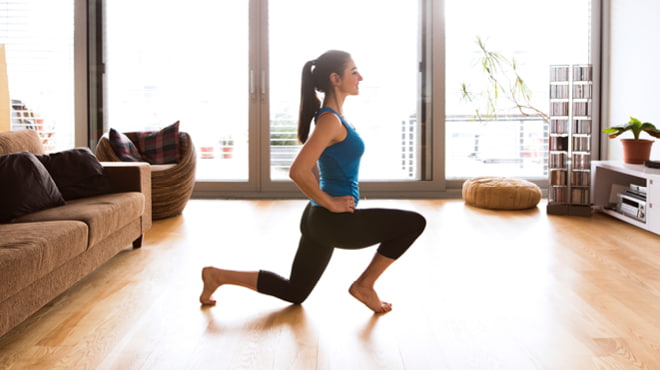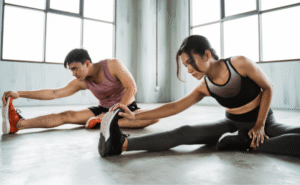Acquaint yourself with your equipment before starting, and seek assistance from a fitness professional if necessary. Warming up with dynamic stretching is an effective way to avoid muscle strains and ligament sprains, especially for beginners. Newcomers should gradually increase the frequency, intensity, and duration of their workouts until reaching full potential.
1. Warm Up
No matter your experience level with physical fitness activities, taking necessary safety precautions to prevent injury is vital for maximizing its health benefits and reaping its rewards without suffering harm that could occur from your fitness regimen. By practicing safety during fitness routines, you can enjoy their many health advantages without fear of unexpected complications arising during a fitness regimen.
Warming up before exercising increases blood flow to the muscles you will be targeting, increasing performance and avoiding injury. Cooling down after your exercise session also benefits performance and prevents injury. Integrating proper form, using appropriate gear, being aware of environmental conditions, and starting slowly can all make a significant difference in avoiding injuries. Should an incident arise that requires medical assistance, consulting an orthopedic specialist like Pinnacle Orthopaedics could help get things back on track more quickly.
2. Wear the Right Gear
Proper gear makes all the difference during a workout, from loose or baggy clothes catching on equipment and hindering performance to moisture-wicking materials that keep you dry and comfortable during exercise. Cotton fabric should be avoided for its moisture-wicking properties that will ensure you remain dry.
Selecting appropriate footwear is also crucial. Avoid jewelry or dangling accessories that could catch on equipment, and opt for shoes specifically designed for athletic use with cushioning and support. Beginners may benefit from consulting a trainer who can give personalized tips, correct form issues, and help set realistic goals; additionally, it would be wise to invest in a treadmill equipped with safety features like emergency stop buttons and handrails.
3. Don’t Overdo It
Exercise can help strengthen you, but it’s essential to be aware of your limits and not overdo it. Pushing too hard could result in injuries such as shin splints, tendinitis, and stress fractures, as well as overtraining syndrome—symptoms including fatigue, decreased performance, and mood changes.
Beginners must be mindful of the potential perils associated with overtraining and consult a trainer or physician to develop an exercise program. Furthermore, imagery and visualization techniques may help novice athletes obtain repetition without over-stretching their bodies.
4. Stay Hydrated
Hydration is one of the key elements to effective exercise. You should aim to take in water whenever thirsty; however, the exact quantity can differ depending on both individual needs and workout goals. One way of tracking hydration levels is through urine color analysis. A properly hydrated person should have pale yellow urine; darker shades indicate they need more fluid intake.
Consideration should also be given to temperature and sweat rate when exercising, as these factors can impact how much you lose. When exercising in intense heat, be vigilant for symptoms of dehydration or heat exhaustion, such as confusion or nausea.
5. Listen to Your Body
As many of us tend to ignore our body’s signals, this can be dangerous. Body psychotherapy, somatic coaching, and trauma-informed bodywork can all provide effective ways for us to reclaim and understand what’s going on inside ourselves and regain our sense of well-being.
Recognizing and understanding body cues—such as feeling your heart beating against your chest during burpees—can help you identify when something might be amiss. A pulse that rises suddenly or takes longer than usual to return back down could indicate illness or heart trouble: seek medical help immediately. Beginners can benefit greatly from using a reliable heart rate monitor during workouts to assist them in learning how best to pace themselves throughout their workout regimens.
6. Don’t Overstretch
Muscle burn is normal during exercise, but it’s essential to understand the difference between pain and overstretching. Overly strenuous stretching may cause stretch-induced injuries, which strain or tear muscles and ligaments in joints.
Overstretching occurs when pushing muscles or joints past their normal range of motion, according to physical therapist Katie Sun Worrall. Overstretching may result in reduced flexibility as ligaments that secure joints loosen over time, according to Worrall. To avoid overstretching, choose slow and controlled movements, such as arm circles or walking lunges; stay away from ballistic stretches that involve bouncy movements; instead, aim for a slight pulling sensation that doesn’t cause pain or discomfort.
8. Don’t Skip the Stretches
Many people neglect stretching after exercising, putting themselves at greater risk of injury and stiff muscles and tendons. Therefore, it is vital that both dynamic and static stretching are part of your exercise routine.
Dynamic stretching (stretches performed while moving) can help increase flexibility and decrease injury risk. Static stretches, held for 30 to 45 seconds, are also crucial in strengthening muscles. Stretches can help safely lower your heart rate. This process is essential since too much physical activity may result in lightheadedness. Stretching may also relieve muscle lactic acid buildup.
9. Stay Safe
Implementing exercise safety helps maximize the health benefits of your routine while also protecting against overexertion or unduly challenging physical activity. Before embarking on any strenuous activities or beginning any fitness regime, it is a smart idea to seek advice from your physician. A simple checkup could reveal any underlying medical conditions that increase the risk of injury.
When exercising outdoors, make sure to wear reflective clothing and carry a cell phone for safety when exercising at night or in high-noise areas, like traffic or areas with high levels of noise. Furthermore, it may help avoid accidents from happening as a result.




